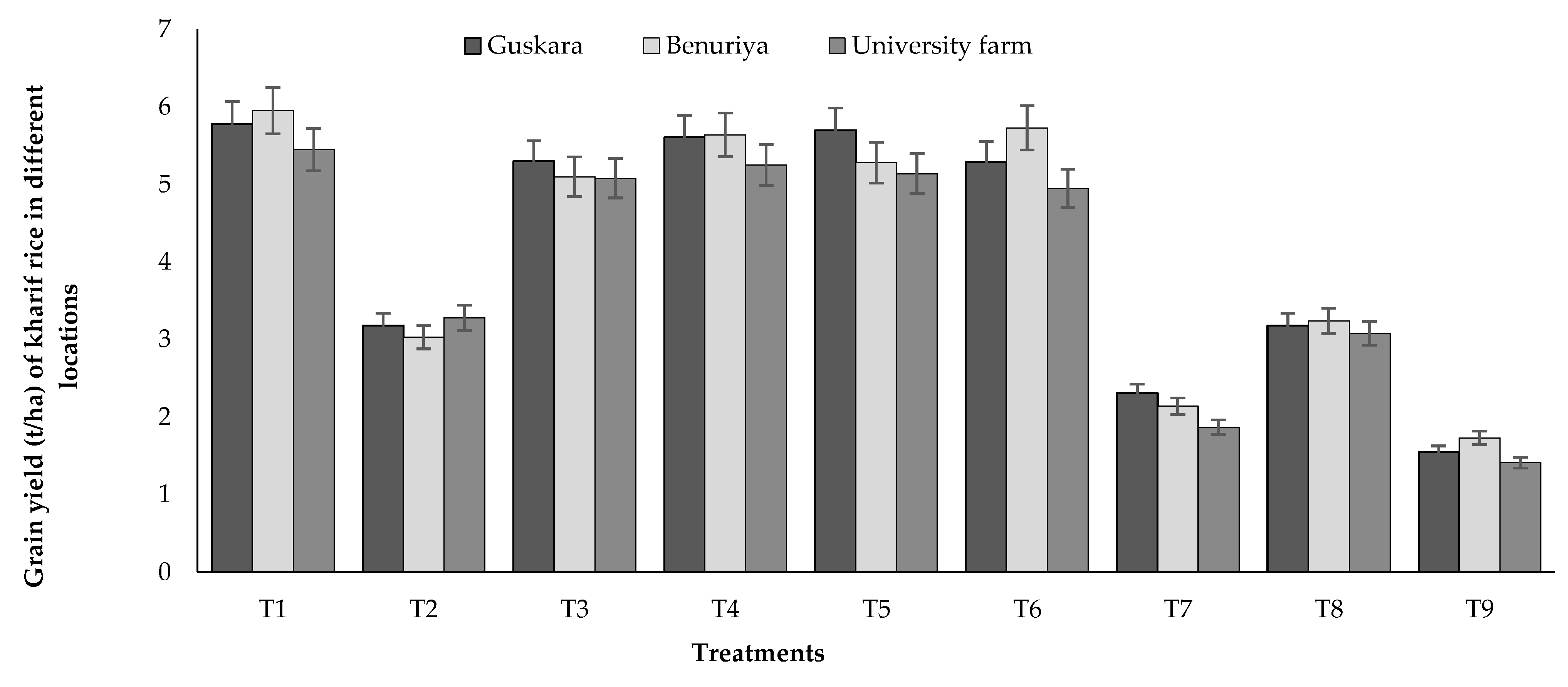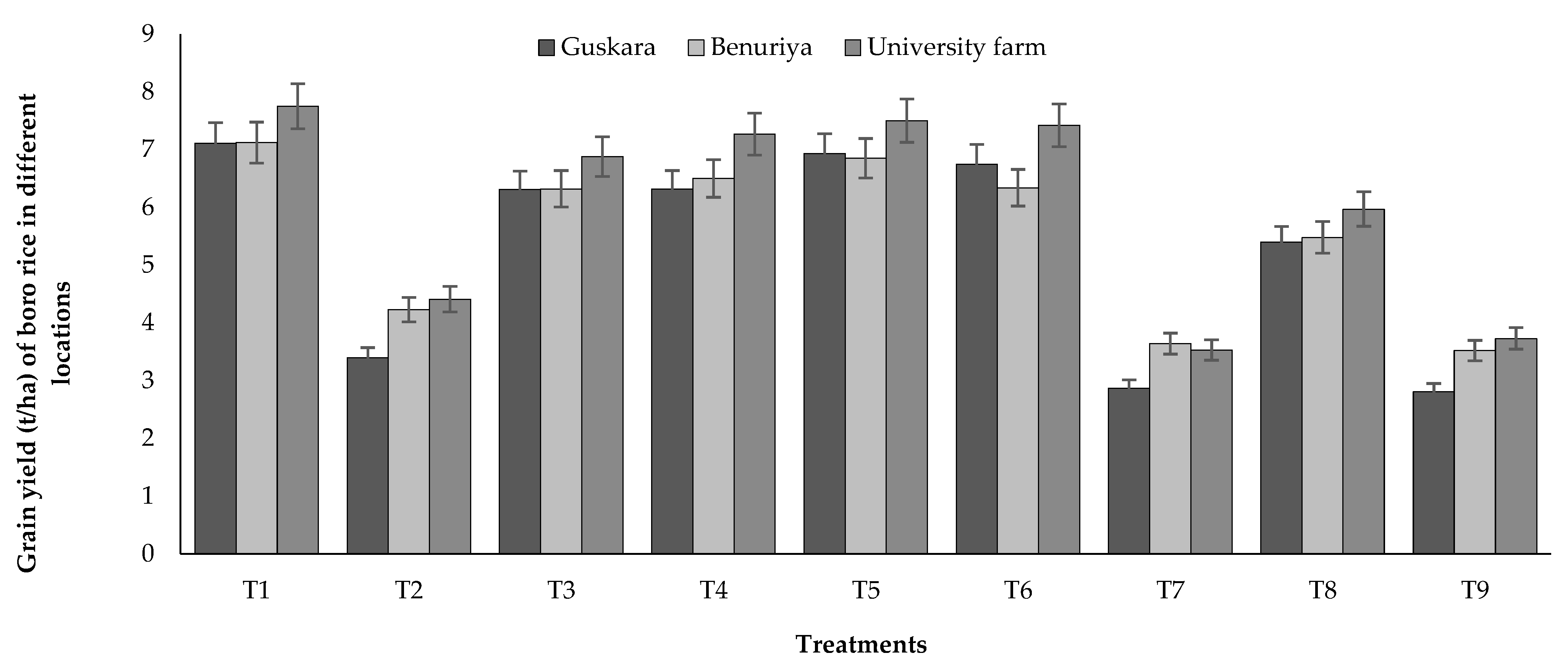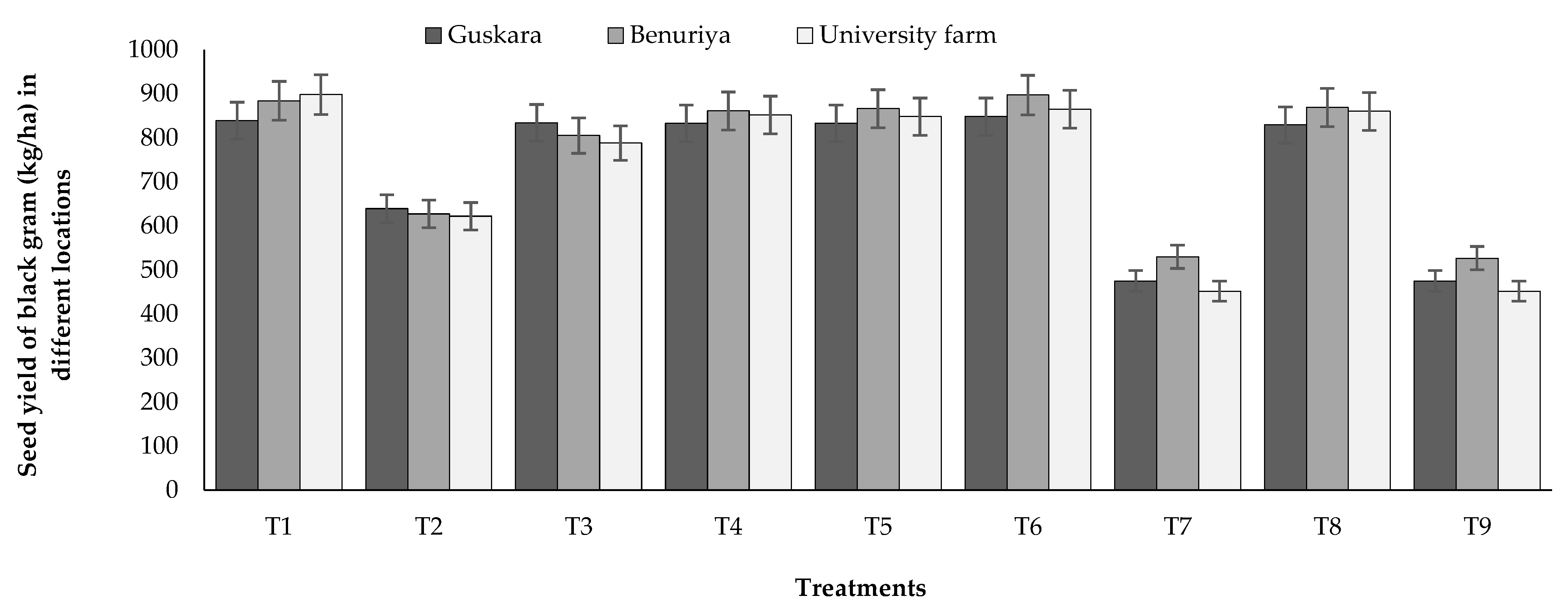1. Introduction
Nutrient management is critical for profitable rice farming in Asia because fertilizers incur the second-highest input cost after labor. A study in seven major irrigated rice areas in six Asian countries showed that fertilizers represented 11 to 28% of the annual costs for farmers producing rice [
1]. Fertilizers must be applied by adopting the 4R rule, that is, right source, rate, time, and place for enhancement of efficiency of nutrients applied by increasing yield. Substantial portions of added fertilizer N are often lost from rice soils as gases through ammonia volatilization and nitrification–denitrification, especially when nitrogenous fertilizer is applied at rates and times synchronized with the demand of the rice crop for supplemental N [
2]. In India, rice is grown in the largest area in the world, with the second-largest production (112.9 Mt) next to China [
3]. Rice occupies 43.7 Mha, and it is about one-fourth of the total cropped area, and more than 40 percent of food grain production [
4]. At the current rate of population growth in India, the requirement for rice is estimated to be around 150 million tons within the next fifty years. To make India self-sufficient in rice, the productivity needs to be improved to a greater extent, compared to the existing condition. Food security in India (with a population of 1.6 billion by 2050, the country requires 450 Mt of food grain production) is a challenge [
5], and the options available are very limited.
Among the various possible genetic approaches to achieve this target, the use of hybrid rice is the most feasible and readily adaptable one, which can increase food production by 15% to 20% [
6]. The commercial success of hybrid rice in China has clearly demonstrated the potential of this technology to satisfy the demands for rice. Efforts to develop and use hybrid rice technology in India, Indian Council of Agricultural Research (ICAR) took the initiative in 1989, with the launch of a mission-oriented project. Within a short period of seven years, half a dozen hybrids from public and private sectors were made available for commercial cultivation. In India, the area under hybrid rice was 2 million hectares, i.e., approximately 5% of the total rice area in 2011–2012.
Growing high yield varieties (HYV) is commonly observed for rice cultivation, especially in the states of eastern India. West Bengal is a leading rice growing state with an area, production, and productivity of 5.15 m ha, 15.09 m ton, and 2933 kg ha
-1, respectively (2017–2018) [
4]. Out of the total rice areas in West Bengal, more than 90% is planted under HYVs, and nearly 5% is covered by hybrid rice. In rice cultivation, high analysis chemical fertilizers are mainly applied to provide three primary nutrients, namely nitrogen (N), phosphorus (P), and potassium (K). However, these fertilizers are not applied in a balanced manner as per the supplier’s recommendations. The farmers are more inclined towards N application which results in imbalanced fertilization. Balanced NPK nutrition is critical for producing maximum rice yield as it promotes vigorous and early plant growth and the development of strong root systems, profuse tillering, flowering, fruiting, and many other biochemical processes in the plant. This practice resulted in a deficiency of some other nutrients, including micronutrients, in the rice-based cropping system [
7]. Micronutrient deficiency in rice is usually mentioned as a “hidden hunger” because its symptoms are hard to watch unless deficient plants are directly compared to sufficient plants [
8].
In this context, site specific nutrient management (SSNM) may be considered as an alternative to a recommended need based fertilizer use across the rice production system as suggested by the International Rice Research Institute (IRRI) [
9,
10,
11,
12]. The hybrids and HYVs of rice are responsive to higher doses of nutrients in enhancing yield [
13]. Rice responds well to added nitrogenous fertilizers to enhance productivity, but nitrogen use efficiency in rice is as low as 30–40%. P and K fertilizers are also important in rice cultivation. The responses of N, P, and K may be assessed by the “Omission Plots” trial techniques where a specific nutrient is going to be omitted to assess the soil’s inherent nutrient supply capacity. Therefore, there is a need for a study with the continuous omission of N, P, and K nutrients from selected plots. Compared to farmers’ practice, improved nutrient management can boost rice productivity. Buresh et al. [
14] carried out field trials on omission plot techniques across the Philippines and noted yield improvement with the application of N, P, and K. The soil test-based approach improved harvest index increased the recovery efficiency of N and K and the corresponding economic benefits from rice cultivation. The N, P, and K rates for a given yield target were determined based on the previous studies for rice [
10,
15,
16].
Kharif rice followed by boro rice followed by pulses is a very common cropping system in different districts of West Bengal. However, there is no specific nutrient management plan related to this rice–rice–pulse (pre-
kharif black gram) cropping system. Further, the nutrient use efficiency has recently gained more attention with rising fertilizer costs and continued concern over environmental impairment. Nutrient use efficiency can be viewed from different perspectives based on yield and removal of nutrients. The most common expression of the efficiency of fertilizer nutrient is defined as the percentage of fertilizer recovered in aboveground plant biomass during the growing season. In general, N, P, and K are considered to estimate nutrient use efficiency. However, P and K can be viewed over the long term, while N efficiency is regarded on a short-term basis because of its transient nature. But where there is potential for building soil reserves, long-term N efficiency is appropriate because soil balance also affects N balance. Hence, a multi-location (both the on-station and on-farm) experiment was carried out to optimize nutrients (N, P, K, S, and Zn) with consideration of nutrient balance and nutrient use efficiency for sustaining productivity of the system and generation of awareness among the farmers about improved nutrient management practice in the rice–rice–pulse cropping system.
2. Materials and Methods
2.1. Site Characteristics
The field experiment was conducted at three different locations, namely, Guskara (Burdwan, 23°54′ N and 87°67′ E) and Benuriya (Birbhum district, 23°66′ N and 87°62′ E) villages in farmers’ fields and at a university farm of Visva-Bharati, Sriniketan, (23°66′ N and 87°65′ E) West Bengal, India under the typical Ultisols of the red and lateritic belt. The climate is sub-tropical, greatly influenced by hot, dry summers and cold winters. It falls in the region of the southwest monsoon, and monsoon rains generally start from the end of June and continue up to the middle of October.
The mean average annual rainfall is 1377 mm, out of which nearly 80–90% is received between June and October. The meteorological data related to the weather conditions prevailing during crop seasons (July 2013 to June 2015) with respect to rainfall, relative humidity, and temperature obtained from the agro-meteorological advisory services of the university is presented in
Figure 1. The initial soil fertility status, particularly pH, organic carbon content (%), available N (kg ha
−1), available P
2O
5 (kg ha
−1), available K
2O (kg ha
−1), available S (kg ha
−1), and available Zn (mg kg
−1) was estimated in the laboratory at the beginning of the experiment (
Table 1 and
Table 2).
Table 1.
Soil testing methodology.
Table 1.
Soil testing methodology.
| Particulars | Method Followed |
|---|
| pH | Determined with the help of pH meter in 1:2.5 ratio of soil water suspension [17] |
| Available nitrogen (kg ha−1) | Alkaline permanganate method [18] |
| Available phosphorous (kg ha−1) | Brays method No.1 [19] |
| Available potassium (kg ha−1) | Flame photometer method [20] |
| Zinc (mg kg−1) | Diethylenetriaminepentaacetate(DTPA) extractable Zn estimation by Atomic Absorption Soectroscopy (AAS) [21] |
| Sulfur (kg ha−1) | Turbid metric method [22] |
Table 2.
Initial soil fertility status (July 2013).
Table 2.
Initial soil fertility status (July 2013).
| Parameters | Soil Test Values |
|---|
| Guskara | Benuriya | University Farm |
|---|
| Textural class | Sandy loam | Sandy loam | Sandy loam |
| Sand (%) | 66.0 | 69.8 | 72.5 |
| Silt (%) | 23.2 | 17.3 | 17.7 |
| Clay (%) | 16.7 | 12.9 | 11.7 |
| Soil pH | 5.12 | 5.30 | 5.11 |
| Electrical conductivity (EC) (dS m−1) | 0.26 | 0.22 | 0.20 |
| Organic carbon (%) | 0.35 | 0.33 | 0.32 |
| Available N (kg ha−1) | 240.6 | 229.2 | 210.6 |
| Available P (kg ha−1) | 12.22 | 11.6 | 11.2 |
| Available K (kg ha−1) | 120.0 | 121.1 | 120.5 |
| Available Zn (mg kg −1) | 0.32 | 0.28 | 0.30 |
| Available S (kg ha−1) | 17.5 | 17.9 | 17.7 |
2.2. Experimental Treatments and Design
The experiment was conducted for two years (six cropping seasons) during 2013–2014 and 2014–2015. The experiment was laid out in a Randomized Block Design with nine treatments (10 m × 10 m plots) and replicated thrice. The following treatments were set: T1: ample dose of N, P, K, S, and Zn; T2: P, K, S, and Zn, T3: N, K, S, and Zn; T4: N, P, S, and Zn; T5: N, P, K, and Zn; T6: N, P, K, and S, T7: local variety under the unfertilized check; T8: local variety under ample fertilizer; T9: control (without any fertilizer). The dose of nutrients in T1 was 150:60:70 kg ha−1 of N:P2O5:K2O and 200:80:90 kg ha−1 of N:P2O5:K2O in the kharif and boro seasons, respectively. In the case of T2: P, K, S, and Zn were applied with an ample dose, and N omitted. In T3: N, K, S, and Zn were applied with an ample dose, P omitted, and the same manner was applied for remaining treatments up to T6. But, in T7 (local variety ‘Kabirajsal’ in was taken in kharif and HYV ‘IR 36′ in boro) as unfertilized control (without any fertilizer) and in T9 (where HYV and hybrid were considered as ‘MTU 7029′ and ‘Arize Tej’ during the kharif and boro seasons, respectively) with ample dose of fertilizer as applied in T1. However, in T8, local variety ‘Kabirajsal’ in kharif and HYV ‘IR 36′ in boro were considered with ample dose of fertilizer as per the recommendations (T1) respectively). The ample dose of N, P, and K were calculated based on yield targets that were 5 t ha−1 and 7 t ha−1 in the kharif and boro seasons, respectively.
2.3. Experimental Procedure
The fertilizers were applied in the plots after layout as per treatments. The sources of fertilizers for nitrogen, phosphorus, and potash were urea, diammonium phosphate (DAP), and muriate of potash (MOP), respectively. The S was applied at 30 kg ha
−1 through bentonite-S (90% S) and Zn at 3 kg ha
−1 through Zn-Ethylenediamine tetraacetic acid (EDTA) (12% Zn) in rice as the basal dose during both seasons. After basal application, the top dressing of the remaining nitrogen was applied in two equal splits at maximum tillering and panicle initiation stages during both seasons. The HYV of
kharif rice was ‘MTU 7029′ and hybrid of the
boro season was ‘Arize
Tej’ for the treatments T1 to T6 and T9, but for T7 and T8, the local variety of rice ‘Kabirajsal’ was taken during the
kharif season and HYV IR 36 was chosen during the
boro season. The black gram cultivar ‘Sarada’ was grown with residual soil fertility, after the harvest of hybrid
boro rice (
Table 3). The crops were irrigated as and when required. The weeds were removed manually at 20 and 40 days after transplanting (DAT). Plant protection measures were taken as per recommended protocols of the university.
2.4. Measurements and Analytical Procedures
2.4.1. Growth and Yield Attributes
The second rows from the border of each side of a plot were destructively sampled to record biometric observations, such as dry matter accumulation, number of tillers, and leaf area index (LAI). To determine yield attributes, five plants of each plot were randomly selected and marked. At maturity, these five plants were harvested, dried and their yield attributes were recorded. To determine dry matter accumulation, rice plants were cut at ground level from each plot randomly as destructive samples. Plants of each plot were dried in a hot air oven, kept at 65 °C for 48 h until constant weights were obtained. The dry weights were recorded and used for the determination of dry matter accumulation. The representative green leaves were taken randomly from destructive samples, and their areas were recorded by leaf area meter. The leaves were then dried in a hot air oven at 80 °C for 10 h until constant weights were obtained, and then weights were recorded. The ratio of leaf area weight
−1 of these leaves was used to measure the leaf area indices. Since LAI is the area of leaf surface per unit of the land surface [
23], it (LAI) was obtained by multiplying this ratio of area and weight with the dry weight of green leaf produced per unit area (square meter) of the land surface. The Leaf Area Index (LAI) during the period of 60 DAT was determined with the following formula (Equation (1)) [
24].
2.4.2. Collection and Analysis of Plant and Soil Samples
The crops were harvested manually from the whole plot (net area of 100 m
2). Grain and straw sub-samples were drawn from each treatment plot after recording the yields. Further, plant samples were chopped into small pieces and washed in acidified detergent solution, and finally rinsed three times in deionized water. These plant samples were dried in a forced-air circulation oven at 65 °C to bring a constant weight. The samples were then pulverized in a wiring blender, which was cleaned with a hairbrush after each sample, and digested in di-acid (9:4
v/
v) of nitric acid (HNO
3)/perchloric acid (HClO
4). The nutrient (N, P, K, S, and Zn) concentration in plant samples was determined by the methods (
Table 1) as described by Subbiah and Asija [
18]. For N content, grain and straw samples were digested in concentrated H
2SO
4-salicylic acid mixture and digestion mixture (potassium sulfate 400 parts, copper sulfate 20 parts, mercuric oxide 3 parts, selenium powder 1 part) and measured by following the micro-Kjeldahl method [
18]. For estimation of P and K in plant samples, the vanadate molybdate method and flame photometer method [
17] were used. The filtered sample was used for zinc (Zn) estimation with the help of atomic absorption spectrophotometer by adopting DTPA extractable Zn estimation method [
21]. Sulfur in whole plant parts and seeds was estimated by the Turbid Metric Method by using a spectrophotometer at 490 λnm, and the concentration was expressed in percentage [
22].
Five soil sub-samples (0–15 cm) from each plot were collected before the growing of rice during
kharif 2013 (initial soil sample) and after the harvest of the crop in the
rabi season of 2015 (post-harvest) using stainless steel tube augers. Initial soil samples were taken from 15cm topsoil. After uniform mixing of sub-samples, representative soil samples were air dried and ground to pass through a 2-mm stainless steel sieve for determination of different soil parameters by standard methods as mentioned in
Table 1. The initial soil fertility has been mentioned in
Table 2.
2.4.3. Calculation of Nutrient Indices
The agronomic efficiency (AE), physiological efficiency (PE), and nutrient response (NR) were calculated using the equations described by Ray et al. [
25] as given below:
where Gf is the economic (grain) yield of the fertilized plot (kg) and Go is the economic yield of the nutrient omitted plot (kg), and Na is the quantity of nutrient applied (kg).
where Ntf is the nutrient accumulation by straw/stover and economic product in the fertilized plot (kg) and Nto is the nutrient accumulation by straw/stover and economic product in the nutrient omitted plot (kg).
2.5. Calculations and Statistical Analysis
The experimental data were analyzed statistically by using analysis of variance (ANOVA). The standard error of means (SEm±) and critical difference at 5% probability level of significance (CD,
p ≤ 0.05) [
26]. The Excel software (Microsoft Office Home and Student version 2019-en-us, Microsoft Inc., Redmond, Washington, (USA) was used for statistical analysis and drawing graphs and figures.
4. Conclusions
The multi-location yield trial on site specific nutrient management (SSNM) clearly indicated that the application of an ample dose of nutrients (100% recommended dose), namely, N, P, K, S, and Zn, is essential to obtain target yield of rice cultivars and higher productivity of rice based cropping systems in the red and lateritic belt of West Bengal. The growth parameters, yield attributes (panicle m−2 and grains panicle−1), and grain yield of kharif and boro rice were enhanced with balance application ample dose of nutrients, and the residual effects of the treatments were also pronounced in terms of productivity of summer black gram. Further, the agronomic efficiency (AE), physiological efficiency (PE), and nutrient response (NR) were maximum with the application of an ample dose of nutrients. The study concludes in favor of the requirement of SSNM for optimization of nutrients in the rice–rice–pulse cropping system for a target yield of rice and need-based S and Zn application for higher productivity.

















